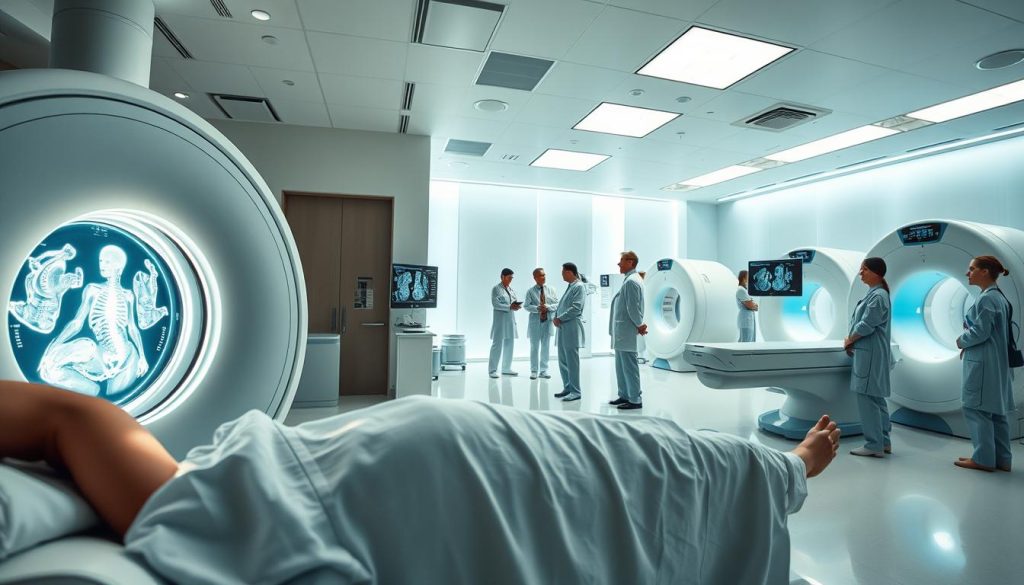Modern healthcare practices rely on medical imaging solutions to deliver precise diagnoses and improve patient outcomes. Advanced medical imaging technologies like MRI, CT, and ultrasound provide clear insights that traditional methods cannot match. Healthcare imaging solutions are no longer optional—they’re essential for staying competitive and meeting patient needs.
Investing in high-quality imaging tools ensures faster, more accurate results. These systems reduce errors, streamline workflows, and build trust with patients. Whether upgrading existing equipment or adopting new healthcare imaging solutions, every practice can benefit from innovation.
Key Takeaways
- Advanced medical imaging boosts diagnostic accuracy and patient safety.
- Healthcare imaging solutions cut costs by minimizing repeat procedures.
- Modern systems integrate seamlessly with electronic health records.
- Upgrading improves practice reputation and attracts more patients.
- Long-term support from providers ensures smooth implementation.
For personalized guidance, contact proprietor Mr. Abdul Alim at +8801711994334. Explore how tailored medical imaging solutions can transform your practice today.
Understanding the Importance of Medical Imaging Solutions
Medical imaging solutions are essential tools that allow healthcare providers to see inside the body safely. These systems help identify injuries, diseases, and abnormalities, leading to faster, more accurate care. Modern medical imaging equipment like MRI machines and X-ray systems are now standard in hospitals and clinics nationwide.
What Are Medical Imaging Solutions?
Medical imaging solutions include all devices and software used to create images of the human body. This includes machines like CT scanners, X-ray units, and ultrasound devices. These tools work together to provide clear views of bones, organs, and tissues, helping doctors make informed decisions. For example, an MRI scanner uses magnetic fields to reveal brain tumors doctors might otherwise miss.
Key Technologies in Medical Imaging
Common diagnostic imaging technology types include:
- X-ray: Quick and cost-effective for fractures and lung issues.
- MRI: Uses magnetic fields to detail soft tissues and organs.
- CT scans: Combines X-rays with computer processing for layered views.
- Ultrasound: Safe for all ages, uses sound waves for real-time imaging.
The Role of Imaging in Patient Diagnosis
Diagnostic imaging technology directly impacts patient outcomes. Early cancer detection via MRI scans saves lives. Accurate images reduce misdiagnoses and risky surgeries. Tools like CT scanners also highlight internal bleeding, allowing immediate care. This technology ensures patients receive the right treatment faster.
For More Information Please Contact Proprietor Mr. Abdul Alim, Cell – +8801711994334.
Types of Medical Imaging Services Available
Healthcare providers today have access to a variety of radiology solutions designed to meet diverse diagnostic needs. Modern diagnostic imaging technology ensures accuracy while adapting to clinical demands. Let’s explore the most common modalities used in practice.
X-ray Imaging Techniques
Digital X-ray systems now offer imaging technology services that cut radiation exposure by up to 50% compared to older models. These upgrades deliver sharper images for bone fractures, lung conditions, and dental assessments. Portable X-ray units also enable bedside imaging in hospitals, streamlining workflows.
MRI and CT Scanning Innovations
MRI machines now use faster scan protocols, reducing exam time by 30% while improving soft-tissue contrast. Advanced CT scanners combine low-dose radiation with 3D reconstruction tools, aiding in trauma and cancer detection. Both modalities rely on cutting-edge diagnostic imaging technology to enhance clinical decision-making.
Ultrasound and Its Applications
Ultrasound stands out for its real-time imaging and safety profile. Applications include:
- Prenatal care for fetal development monitoring
- Musculoskeletal exams for tendon or joint injuries
- Emergency rooms for rapid trauma assessments
“Ultrasound’s non-invasive nature makes it ideal for pediatric and geriatric patients,” explains Dr. Emily Torres, a leading diagnostic specialist.
Each imaging modality plays a unique role in modern healthcare, offering tailored solutions for every specialty.
Benefits of Advanced Medical Imaging Solutions
Modern advanced medical imaging technologies are transforming healthcare by delivering measurable advantages for both providers and patients. These innovations, such as healthcare imaging solutions, now offer clearer insights while streamlining workflows. Let’s explore three key benefits driving their adoption:

Enhanced Diagnostic Accuracy
High-resolution scans and AI-driven analysis in digital imaging solutions reduce misdiagnoses. For example, MRI and CT systems now detect early-stage conditions like tumors or fractures that older equipment might miss. This precision leads to faster, more targeted treatments.
Increased Patient Safety
Modern systems cut radiation exposure by up to 40% compared to legacy devices. Less invasive procedures and real-time imaging adjustments also lower complication risks. Patients gain confidence knowing scans are both safe and thorough.
Cost-Effectiveness Over Time
- Fewer repeat scans due to clearer images
- Lower error rates reduce unnecessary treatments
- Streamlined workflows boost daily patient capacity
Investing in top-tier healthcare imaging solutions pays off long-term. Hospitals like Johns Hopkins have reported 30% cost savings by adopting these systems, proving value beyond initial costs.
Choosing the Right Imaging Equipment for Your Practice
Selecting the right medical imaging equipment shapes the foundation of your practice’s success. This guide simplifies decision-making with actionable steps to align choices with your practice’s unique needs.
Factors to Consider When Selecting Equipment
- Practice size and daily patient volume
- Patient demographics and common diagnoses
- Space requirements and room layout
- Budget allocation and long-term investment goals
- Technical capabilities needed for diagnoses
New vs. Refurbished Imaging Solutions
Compare options:
- New systems: Offer cutting-edge medical imaging solutions, full warranties, and extended lifespan.
- Refurbished models: Cost-effective but check warranty terms and technology age.
Partnering with Reputable Manufacturers
Choose vendors with:
- Proven industry experience
- Access to reliable imaging technology services like maintenance and training
- 24/7 technical support
Mr. Abdul Alim, a trusted advisor in healthcare tech, offers personalized consultations to tailor choices to your practice. Call +8801711994334 for expert guidance.
Integrating Medical Imaging into Your Workflow
Adopting healthcare imaging solutions demands more than just installing new equipment. Success hinges on aligning technology with daily operations. Start by mapping current processes and identifying gaps. Small steps, like digitizing records or upgrading software, can simplify transitions. The right imaging technology services providers offer tailored strategies to fit your practice’s unique needs.
Streamlining Patient Processes
Efficiency starts with patient flow. Consider these steps:
- Automate appointment scheduling via cloud-based systems.
- Use digital imaging solutions to share results instantly with referring physicians.
- Train staff to use touchscreen kiosks for check-in and consent forms.
Training Staff on New Technologies
Teams thrive with hands-on practice. Plan these steps:
- Host weekly training sessions focused on specific tools.
- Assign a tech-savvy team member as an in-house trainer.
- Encourage feedback to address challenges early.
Ensuring Compliance and Safety Standards
Safety protocols protect patients and staff. Prioritize:
- Radiation safety training for imaging staff.
- Quarterly equipment calibration checks.
- Regular audits of data privacy compliance.
Smooth integration balances technology with teamwork. Partner with vendors offering ongoing support to troubleshoot issues quickly. Remember, gradual implementation reduces disruptions and builds confidence.
Innovations Shaping the Future of Medical Imaging

“AI-driven tools are not just tools—they’re partners in delivering faster, more precise care.” — Dr. Lena Torres, Imaging Technology Innovator
The medical field is witnessing groundbreaking leaps in how images are captured, interpreted, and shared. These advancements promise to reshape every aspect of patient care. Let’s explore three key trends leading this transformation.
Artificial Intelligence in Imaging
AI-driven image analysis software is automating routine tasks like tumor detection and anomaly identification. Algorithms learn from vast datasets, flagging findings for faster review. This reduces human workload while spotting details invisible to the naked eye. Hospitals using these tools cut diagnosis times by up to 40%, per recent studies.
3D Imaging and Virtual Reality
3D imaging now creates lifelike organ models from scans, revolutionizing surgical prep. Surgeons preview procedures in virtual reality, minimizing risks. These advanced medical imaging techniques also train medical students through immersive simulations, bridging classroom theory and real-world practice.
Telemedicine and Remote Imaging
Digital imaging solutions now enable clinics to share scans instantly with specialists anywhere. Rural providers use these systems to consult with urban experts, expanding access to care. During emergencies, ER teams can send X-rays to off-site radiologists, ensuring rapid decisions even in underserved regions.
These tools aren’t distant dreams—they’re here. Adopting them today ensures practices stay ahead of evolving patient needs and regulatory standards.
Improving Patient Experience Through Better Imaging
Modern healthcare imaging solutions are transforming how patients interact with diagnostic care. By focusing on comfort, clarity, and ongoing support, practices can turn imaging visits into positive, reassuring experiences. These advancements not only improve satisfaction but also strengthen trust between providers and patients.
Comfort and Privacy During Procedures
Comfort begins with equipment design. Healthcare imaging solutions now now feature:
- Quieter machines to reduce noise stress
- Spacious scanners to ease claustrophobia
- Privacy-focused software that limits unnecessary data sharing
These innovations ensure patients feel safe and respected during scans.
Clear Communication of Results
Medical imaging solutions include tools that simplify complex findings. Providers use:
- 3D visualizations to show anatomy clearly
- Plain-language summaries of scans
- Online portals for secure result sharing
Visual aids and open discussions help patients understand next steps without confusion.
Follow-Up Care and Support
Imaging technology services extend beyond scans to long-term care. Practices can:
- Link imaging results to personalized treatment plans
- Offer educational materials on diagnoses
- Facilitate referrals to specialists via integrated systems
This holistic approach ensures patients feel supported every step of the way.
Case Studies: Successful Implementation of Imaging Solutions
Real-world examples show how healthcare providers are transforming care with advanced imaging. Here are three stories of facilities that achieved measurable success.
Clinic A: Revolutionizing Radiology Practices
Clinic A upgraded to new medical imaging equipment, reducing scan times by 40%. Staff training on radiology solutions cut report turnaround from 24 hours to 2 hours. Patient wait times dropped by 35%, boosting clinic revenue by 22% in one year.
Hospital B: Emergency Care Innovations
This hospital deployed image analysis software in ER trauma bays. Doctors now analyze scans 60% faster using AI-driven medical imaging equipment. Stroke patients received clot-busting treatment 30% quicker, improving survival rates by 18%.
Practice C: Streamlining Workflows
A multi-specialty group integrated radiology solutions with EHR systems. The image analysis software reduced misdiagnosis errors by 25%. Specialists now share imaging data instantly, cutting consultation delays by half.
These examples highlight how tailored radiology solutions and medical imaging equipment can address specific challenges. Key lessons include investing in staff training and selecting systems that fit workflow needs. Each facility saw ROI within 18 months through efficiency gains and better patient outcomes.
Choosing the Right Partner for Medical Imaging Solutions
Selecting the right partner is key to maximizing the benefits of medical imaging solutions. Your provider should align with your practice’s goals, ensuring technology meets both current and future needs. Here’s how to find the best fit.
Evaluating Vendors and Their Support
Start by assessing vendors who specialize in imaging technology services. Look for those offering detailed training programs and technical support. Ask about their experience with diagnostic imaging technology systems and how they address equipment compatibility and workflow integration.
The Importance of After-Sales Service
Reliable after-sales service ensures your systems stay efficient. Prioritize partners that provide regular maintenance, rapid troubleshooting, and software updates. Proactive support extends the lifespan of medical imaging solutions, reducing downtime and costs.
Building Long-Term Relationships for Success
A strong partnership adapts as your practice evolves. Seek vendors who offer ongoing consultation and stay updated on industry trends. Long-term collaborators like Mr. Abdul Alim, a specialist in imaging technology, can guide practices through upgrades and operational challenges.
For personalized advice or to discuss your practice’s needs, contact Mr. Abdul Alim directly at +8801711994334. His expertise in imaging systems ensures tailored solutions that enhance diagnostic accuracy and operational efficiency.
